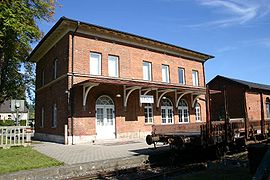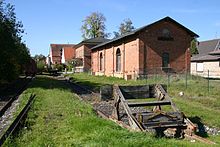Georgensgmünd – Spalt railway line
| Georgensgmünd – gap | |||||||||||||||||||||||||||||
|---|---|---|---|---|---|---|---|---|---|---|---|---|---|---|---|---|---|---|---|---|---|---|---|---|---|---|---|---|---|
|
Spalt railway station (2007)
| |||||||||||||||||||||||||||||
| Route number : | 5945 | ||||||||||||||||||||||||||||
| Course book range : | ex 413k | ||||||||||||||||||||||||||||
| Route length: | 6.9 km | ||||||||||||||||||||||||||||
| Gauge : | 1435 mm ( standard gauge ) | ||||||||||||||||||||||||||||
|
|||||||||||||||||||||||||||||
The Georgensgmünd – Spalt railway line , also popularly known as Spalter Bockl , was a branch line in Bavaria . It branched off from the main Treuchtlingen – Nuremberg line in Georgensgmünd and led to Spalt .
Planning and construction
Initial plans to route the Ludwigs-Süd-Nord-Bahn Lindau - Nuremberg via Gunzenhausen- Spalt-Georgensgmünd were not realized. The Spalter hop farmers are said to have prevented this due to the fear of deterioration in the quality of the world-famous hops because of the steam engines . When the railway was later recognized as a means of transport, the city of Spalt asked several times for a connection to the railway at Georgensgemünd, but ultimately had to pay the construction costs of 80,000 guilders itself according to the Vizinalbahngesetz .
Civil engineer Schmidt from the Nuremberg Railway Construction Section worked out a total of 4 possible route variants between 1870 and 1872, the first of which was finally implemented. Compared to the other routes, it had the shortest route and the fewest construction work and was therefore the cheapest. The city of Spalt also took measures to reduce costs, for example the 14 engineering structures (bridges and culverts) were built from stones that were left when the city wall was demolished. The route consists of almost 3/4 straight lines, only six curves were necessary. The tightest curve radius was 750 meters, the shortest distance between two back straight 188.50 meters. The underground of the railway line consisted of grown clay and sand, only a short piece of bog had to be removed down to the sand sole. Cuts were in some cases dug up to 3 meters deep, embankments up to 8.5 meters high, using sand and clay here too. A total of around 120,000 cubic meters of earth was moved. The rails as well as the switches and crossings made of cast steel were supplied by the company Späth from Nuremberg, where two profiles were used. A local stonemason made kilometer stones for 50 kreuzers each including delivery.
On October 16, 1872, the railway line was opened as the second vicinal railway by the Bavarian State Railways .
business
The first train reached Spalt on September 18, 1872, and the branch line began operating on October 16. Initially, three pairs of trains drove daily, which were supplemented by another two to three connections in the last few years of operation. The Wasserzell and Hügelmühle stops, which were only set up in 1892 and 1897, were served until 1922 and 1924, respectively. A large wine garden stop was created for this purpose.
In order to make the operation more economical, the extension of the railway to Windsbach was planned in 1914 and the route was marked out. Further work was delayed by the outbreak of World War I and afterwards the Deutsche Reichsbahn stopped pursuing it.
As on the other Vizinalbahnen, traffic was initially handled with old main railway locomotives. After several unsuccessful experiments with special branch line locomotives, the first "glass boxes" of the PtL 2/2 series were put into operation in 1905 , and were to shape the image of the line in the decades that followed. The era of these locomotives ended in 1963 with the decommissioning of 98 307, which ran between Spalt and Georgensgmünd until the end. The operating center of the line was the Spalt station. The locomotives stayed in the two-hour locomotive station at the exit towards Georgensgmünd.
On September 28, 1969, passenger traffic on the 6.9-kilometer line was shut down by the Deutsche Bundesbahn , although the line had been completely renovated in 1963. Freight traffic was continued until May 28, 1995. Occasionally the route was also used by special trains, especially to the rubble landfill operated by the DB, in which, among other things, dismantled gravel and debris from dismantled platforms were deposited.
In the meantime, the railway line has been converted into a cycle path . The train station of the town of Spalt has been restored and is now the cultural center of the town as a cultural train station . The "Spalter Bockl" can be viewed in the German Steam Locomotive Museum in Neuenmarkt (Upper Franconia).
literature
- Bleiweis, Wolfgang / Martin, Ekkehard: Franconian branch lines - Middle and Lower Franconia , Egglham 1986/87?
- Heimatverein Spalter Land: From the Spalter Land, Heimatkundliche Hefte. Line. Issue 11, 1972.
Web links
swell
- ↑ From the Spalter Heimat, book series by the Heimatverein Spalter Land, volume 11


